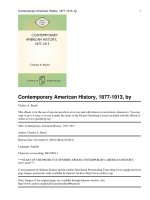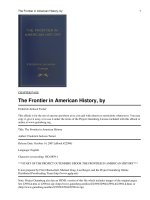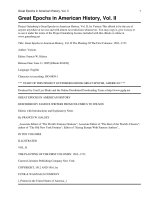native american history
Bạn đang xem bản rút gọn của tài liệu. Xem và tải ngay bản đầy đủ của tài liệu tại đây (7.89 MB, 252 trang )
Published in 2011 by Britannica Educational Publishing
(a trademark of Encyclopædia Britannica, Inc.)
in association with Rosen Educational Services, LLC
29 East 21st Street, New York, NY 10010.
Copyright © 2011 Encyclopædia Britannica, Inc. Britannica, Encyclopædia Britannica,
and the Thistle logo are registered trademarks of Encyclopædia Britannica, Inc. All
rights reserved.
Rosen Educational Services materials copyright © 2011 Rosen Educational Services, LLC.
All rights reserved.
Distributed exclusively by Rosen Educational Services.
For a listing of additional Britannica Educational Publishing titles, call toll free (800) 237-9932.
First Edition
Britannica Educational Publishing
Michael I. Levy: Executive Editor
J.E. Luebering: Senior Manager
Marilyn L. Barton: Senior Coordinator, Production Control
Steven Bosco: Director, Editorial Technologies
Lisa S. Braucher: Senior Producer and Data Editor
Yvette Charboneau: Senior Copy Editor
Rosen Educational Services
Jeanne Nagle: Senior Editor
Nelson Sá: Art Director
Cindy Reiman: Photography Manager
Matthew Cauli: Designer, Cover Design
Introduction by Sean McCollum
Library of Congress Cataloging-in-Publication Data
Native American history / edited by J.E. Luebering. — 1st ed.
p. cm. — (The Native American sourcebook)
“In association with Britannica Educational Publishing, Rosen Educational Services.”
Includes bibliographical references and index.
ISBN 978-1-61530-265-9 (eBook)
1. Indians of North America—History. I. Luebering, J. E.
E77.N3513 2011
970.004'97—dc22
2010011741
On the cover: Representatives from various Native American tribes depicted in the 1800s.
Engraving after an illustration by R. Huttula. Hulton Archive/Getty Images
On pages 17, 27, 46, 58, 70, 94, 109, 126, 143, 161, 193, Phil Schermeister/National
Geographic Image Collection/Getty Images
CONTENTS
36
Introduction 10
Chapter 1: Tracing Native American
History 17
Ancestral Roots 17
Indigenous Peoples of North America 18
Early Cultural Development 18
Tribe and Band 23
Tribal Nomenclature 24
Chapter 2: Tribes of the Arctic and the
Subarctic 27
The Arctic 28
Eskimo 32
Aleut 34
Native American Self-Names 35
The Subarctic 37
Innu 37
Cree 37
Ojibwa 38
Grand Medicine Society 39
Chipewyan 39
Beaver 41
Slave 41
Carrier 42
Gwich’in 43
Tanaina 43
Deg Xinag 44
Chapter 3: Northeast Native
Americans 46
Algonquin 47
Iroquois 47
Huron 49
Wampanoag 50
Mohican 51
Mohegan 51
King Philip’s War 52
Ho-Chunk 53
Sauk 55
Fox 56
Illinois 57
40
54
79
Chapter 4: The Southeast 58
Cherokee 59
Choctaw 62
Chickasaw 63
Creek 63
Seminole 65
Natchez 66
Caddo 67
Apalachee 68
Timucua 69
Chapter 5: Peoples of the Plains 70
Mandan 71
Hidatsa 73
Omaha 74
Pawnee 75
Arikara 76
Crow 78
Sioux 80
The Sioux Way of Life 80
Precontact Sioux Culture 81
The Beginning of the Struggle for the West 81
The Battle of the Little Bighorn and the
Cessation of War 84
Blackfoot 85
Cheyenne 85
Sitting Bull 86
Comanche 88
Arapaho 90
Kiowa 92
Chapter 6: The Southwest 94
Pueblo Indians 95
Zuni 97
Kachinas 98
Hopi 99
Yuman 100
Pima 101
Tohono O’odham 102
Navajo 104
Apache 105
Geronimo 107
91
99
112
Chapter 7: The Great Basin and
Plateau 109
The Great Basin 111
Mono 111
Paiute 111
Bannock 113
Shoshone 114
Ute 116
Gosiute 116
The Plateau 116
Salish 117
Flathead 118
Nez Percé 120
Yakima 121
Kutenai 122
Modoc and Klamath 123
124
Chapter 8: The Northwest Coast and
California 126
The Northwest Coast 126
Tlingit 127
Haida 128
Tsimshian 129
Kwakiutl 130
Bella Coola 132
Nuu-chah-nulth 133
Coast Salish 134
Chinook 134
California 135
Hupa 136
Yurok 136
Pomo 137
Yuki 139
Wintun 140
Maidu 140
Yana 141
Chapter 9: Prehistory 143
Paleo-Indian Cultures 143
The Clovis and Folsom Cultures 144
Pre-Clovis Cultures 146
128
153
Archaic Cultures 146
Pacific Coast Archaic Cultures 147
Domestication 148
Desert Archaic Cultures 148
Plains Archaic Cultures 148
Eastern Archaic Cultures 149
Tools of Archaic Cultures 150
Prehistoric Farmers 151
Southwestern Cultures: The Ancestral Pueblo,
Mogollon, and Hohokam 152
Pueblo Architecture 155
Eastern Woodland Cultures 157
Mississippian Cultures 158
Plains Woodland and Plains Village
Cultures 159
154
Chapter 10: From 1492 through the 18th
Century 161
North America and Europe circa 1492 161
Culture Area 162
Native American Ethnic and Political
Diversity 163
European Populations and Polities 164
Colonial Goals and Geographic Claims: The 16th
and 17th Centuries 166
Spain 166
France 167
England 169
The Netherlands and Sweden 170
Native Americans and Colonization: The 16th and
17th Centuries 171
The Southwest Indians 171
Pueblo Rebellion 172
The Southeast Indians 172
The Northeast Indians 175
Blood Feud 179
The Subarctic Indians and the Arctic
Peoples 179
The Chessboard of Empire: The late 17th to the
Early 19th Century 181
Eastern North America and the Subarctic 181
The Southwest and the Southern Pacific
174
212
Coast 187
The Northern Pacific Coast 187
Tecumseh 188
The Plains and Plateau Culture Areas 190
Chapter 11: From the 19th to the 21st
Century 193
Removal of the Eastern Nations 193
The Conquest of the Western United States 195
On Indian Removal 196
The Conquest of Western Canada 199
The Red River Crisis and the Creation of
Manitoba 199
The Numbered Treaties and the Second Riel
Rebellion 202
Assimilation Versus Sovereignty: The Late 19th to
the Late 20th Century 204
Allotment 205
Indians and Whites 208
Boarding Schools 209
Reorganization 211
False Sentimentality About Indians 212
Termination 215
The Disillusioned Indian 216
Developments in the Late 20th and Early 21st
Centuries 218
The Outplacement and Adoption of
Indigenous Children 221
Religious Freedom 224
Repatriation and the Disposition of the
Dead 226
Economic Development: Tourism, Tribal Industries,
and Gaming 228
Indian Gaming 232
International Developments 234
Conclusion 234
Glossary 236
Bibliography 238
Index 240
225
230
INTrODuCTION
Introduction | 11
I
f a family story has been forgotten, did
the events really occur? If no one
knows the function of a stone tool, what
has been lost? When it comes to the history of the indigenous peoples of North
America, these are more than just academic or philosophical questions. They
embody the challenge and hope of piecing together the unique worlds, past and
present, of Native Americans.
This book explores the long history
of the native peoples of North America,
which reaches back more than 10,000
years, and the myriad cultures and languages that emerged over time. It
examines closely the consequences of
contact between Native Americans and
European settlers, who began their conquest of the Americas in the 15th century,
with the arrival of Christopher Columbus
in the so-called New World. This book
also traces the endurance of Native
American traditions and culture to the
present day and details contemporary
expressions by native peoples of their
identities and sovereignty.
When the first nomadic hunter-gatherers came to the Americas remains an
matter of debate. Archaeological evidence
indicates that at least 13,000 years ago
humans migrated from northeastern Asia
to northwestern North America by way of
a land bridge known as Beringia. Nomadic
family-based bands of peoples called
Paleo-Indians were hunters and gatherers.
Their pursuit of food most likely led them
eastward, travelling by foot or boat down
the North American coast. Some groups
continued their migration along the
Pacific coastline, while others worked
their way eastward across present-day
Alaska and the western Canadian provinces before turning southward.
Archaeologists have established
points in time and space for these peoples mostly by examining stone tools.
The Monte Verde archaeological site in
Chile, dating back to 10,500 bc, and the
site near Clovis, N.M., with stone spear
points and other artifacts that date to
about 9000 bc, have been especially
fruitful in this regard. The diversity
of languages and cultures that subsequently developed in North America is
astonishing. Consider that at the time of
European contact, American Indian languages in North America included more
than 50 language families made up of
about 300 to 500 languages.
Paleo-Indian groups throughout
the Western Hemisphere also demonstrated formidable adaptability. Those
that drifted northward developed hunting and gathering skills suited to the
environmental extremes of the Arctic
and sub-Arctic regions. The people of
the Old Cordilleran culture of the Pacific
Northwest oriented their culture toward
the abundance of coastal resources, from
salmon to wild berries.
Travellers Meeting with Minatarre Indians near Fort Clark, aquatint by Karl Bodmer, 1842.
Library of Congress, Washington, D.C.
12 | Native American History
Archaeological evidence suggests
Native Americans were experimenting
with agriculture during the Archaic
Period, perhaps as early as 6000 bc. Early
Southwest Indians started planting corn
(maize) in that semiarid region by about
1200 bc. Over the next millennium, farming practices had taken root in the
cultures of many American Indian
groups, allowing more sedentary and
stratified societies to emerge. Farming
cultures included the Adena culture (c.
500 bc–ad 100), in the Ohio River valley,
and the nearby Hopewell culture (c. 200
bc–ad 500). Excavations of burial sites in
Ohio and Illinois established that these
peoples also created widespread trade
networks that reached south to the Gulf
of Mexico and west to the Rocky
Mountains.
After ad 700, a new power rose in the
Mississippi valley, and its influence
spread rapidly into the southeast and
northeast. Known as the Mississippian
culture, its most striking remnants are
massive temple mounds. These earthen
construction often encompassed a large
plaza, with important council buildings
and temples erected on their level tops.
In its heyday, the Mississippian capital
city (now known as Cahokia, near present-day St. Louis, Mo.) featured 120 such
mounds and a population that some
anthropologists estimate might have
been as high as 40,000, making it the
most expansive urban center north of
Middle America (the area from northern
Mexico to Nicaragua).
When the ships of Christopher
Columbus made landfall on Hispaniola in
1492, events were set in motion that sent
shockwaves through virtually every indigenous culture in the Western Hemisphere
and shattered many. Columbus’s assumption that he had arrived in India also left
American Indians with the name that
they have borne ever since.
Over the next 200 years, several
European powers established footholds in
the Americas, vying to expand their
empires. Spain, whose monarchs sponsored Columbus’s explorations, led the
way with waves of military expeditions
seeking whatever wealth they could find,
especially gold, to prop up the country’s
struggling economy. Francisco Vázquez de
Coronado infiltrated the southwest while
Hernando de Soto and his troops wrested
control of what is now Florida, making
slaves of the native inhabitants and
destroying many villages along the way.
Also seeking riches, in order to support its frequent wars around the globe,
was France. In 1534, French explorer
Jacques Cartier entered the Gulf of St.
Lawrence and claimed the region known
as New France. Instead of gold, the French
found wealth in furs and other trade, and
they established settlements along waterways to expedite their enterprises.
England’s main objectives focused
less on immediate wealth than on territorial gains. King James I approved
commercial ventures to pursue English
aims, including the Virginia Company
and the Massachusetts Bay Company, and
Introduction | 13
offered land grants to religious groups
such as the Quakers.
To accomplish their goals, these three
European powers approached colonization of North America in different ways.
As the Spanish extended their control
across present-day Mexico and the
American southwest through the 16th–
18th centuries, they established a form of
feudal system built around plantations
and Roman Catholic missions, with
Native Americans as serfs. French trappers built strong partnerships with the
Huron, Algonquin, and other northern
native peoples. These partnerships,
which included intermarriage, were
designed to further the lucrative fur trade.
The English approach, though, had the
most success. The right to earn title to
property inspired average land-hungry
English subjects to leave their homeland
to stake claims and build new lives across
the Atlantic.
While the indigenous peoples of
North America viewed land largely as a
resource to be managed and used communally, Europeans believed in outright
ownership. While Indian leaders might
interpret colonial gifts and tributes as a
form of rent, for example, colonists might
view them as payment for possession.
Often, reconciling these worldviews
proved beyond the power of peaceful
negotiations. Reducing interactions of
the Europeans and American Indians to a
two-sided conflict, however, oversimplifies the evolving complexity of the
situation. Tribes formed political and
military alliances with European factions
in efforts to gain advantage over their traditional Native American enemies. In the
early 1600s, for example, the Huron and
others in coalition with them allied themselves with the French, then used the
alliance, as well as European weapons
and tactics, to battle the Iroquois
Confederacy. The Iroquois, in turn, joined
forces with the English.
Two crucial factors contributed to
the precipitous decline of the Huron and
demonstrate the type of chain reactions
that European colonization triggered in
North America. Spurred by economic
relations with the French, the Huron alliance shifted away from a subsistence
economy to one based on trade. When
the beaver population declined, however, the Huron were left destitute and
starving. Additionally, a smallpox outbreak is thought to have killed as many
as two-thirds of the Huron coalition.
It is difficult to overstate the impact
disease had on American Indian tribes.
In many instances, epidemics of smallpox, measles, typhus, cholera and new
strains of flu often played a decisive
role in reducing tribes’ ability to resist
encroachment. Ethnohistorian Henry
Dobyns estimated mortality rates as
high as 95 percent for some American
Indian groups.
Europeans brought more than
disease to their contact with Native
Americans. In the 1700s Plains
Indian tribes such as the Comanche,
Cheyenne, and Sioux benefited from
14 | Native American History
the introduction of horses, which were
brought to the continent by Spanish
conquistadors. Horses made these tribes
more mobile and, combined with newly
arrived firearms, greatly increased their
hunting effectiveness and their ability
to wage war, amongst themselves and
against European settlers.
In the 19th century, a pattern of
Indian removal began in earnest in the
United States and Canada. In 1830, the
U.S. Congress passed the Indian Removal
Act in response to the discovery of gold
on Cherokee land in Georgia. Under
pressure from Pres. Andrew Jackson, legislation was passed that allowed the
president to divest American Indian
tribes of land in exchange for land, almost
always inferior, in the West. In 1831, the
U.S. Supreme Court ruled in Cherokee
Nation v. Georgia that indigenous peoples on American soil were dependent
rather than independent nations. The ruling took away many of the legal avenues
tribes might have used to fight these
expropriations.
In 1838, tens of thousands of
Southeast and Northeast Indians began
the march west along the infamous Trail
of Tears during relocation west of the
Mississippi River. A similar process of
relocation was repeated with other tribes
throughout much of the 19th century.
When they balked, U.S. troops were
quickly called out to crush resistance.
With the ending of the American
Civil War in 1865, only the tribes of the
central and western Plains and American
Southwest remained outside of U.S.
government control. With the war over,
U.S. troops soon moved westward to force
these groups onto reservations or kill
them. The Plains Indians tried to protect
their homes and families but were at a
distinct disadvantage. The 1876 annihilation of George Armstrong Custer’s 7th
Cavalry by an alliance of Dakota and
Northern Cheyenne at the Battle of the
Little Bighorn proved the most famous
Indian victory in this last stand against
U.S. power and control. In December of
1890 the rebuilt U.S. 7th Cavalry massacred more than 200 Sioux men, women,
and children near Wounded Knee, S.D. It
served as the bloody conclusion to the
conquest of the North American Indian.
The fate of most Native Americans
now entered a new phase featuring
the struggle between assimilation into
the dominant white American culture
and the pursuit of sovereignty, or selfdetermination. The policy of the U.S.
government was one of assimilation.
Many officials in the U.S. and Canada
believed the best course was, in the words
of U.S. Army Capt. Richard Pratt, to “kill
the Indian in him, and save the man.”
Pratt was one of the architects of a system of Indian boarding schools, the most
famous of which is the Carlisle Indian
Industrial School in Pennsylvania. Indian
children were taken from their families, as compelled by law, and shipped
to these distant institutions. There they
were remade in Euro-American clothes
and haircuts, punished for speaking their
tribal languages, forced to renounce
their religions and convert to Christianity,
Introduction | 15
and managed with military-like discipline. Emotional, physical, and sexual
abuse were common; the deaths of students were not uncommon.
Tribes were sequestered on reservations, many of which had been carved out
of lands that were infertile and essentially
valueless. Another devastating policy,
termination, decreed that indigenous
individuals in Canada and tribes in the
United States could be stripped of their
aboriginal status, which freed governments from promised support.
Native Americans, however, refused
to vanish, as some observers had predicted they would. Gradually, the pursuit
of sovereignty gained momentum. A
major shift came in 1934 with the passage
of the Indian Reorganization Act by the
U.S. Congress. This law included prohibitions against the allotment of tribal lands,
the right of tribes to compose written
constitutions and charters to manage
their affairs, and federal programs to help
improve tribal economies, health care,
and education.
Many tribes seized upon these opportunities, forming tribal governments that
combined traditional leadership practices with parliamentary procedure. They
pursued newly opened legal avenues to
force the U.S. government to uphold
treaty rights. A congressional Indian
Claims Commission set up in 1946 considered petitions regarding Indian land
claims. These claims often resulted in
substantial compensation for the tribes.
The civil rights movement of the 1950s
and 1960s helped bring additional attention and support to their cause. New laws
restored religious freedoms and resource
rights as a pan-Indian movement grew.
In the 21st century poverty, underdevelopment, substance abuse, and other
economic and social ills still plague
many of North America’s native peoples.
If tribes on reservation lands were considered their own country, they would
qualify for “developing nation” status by
the World Bank, based on per-capita
income. However, the pursuit of selfdetermination continues to return power
and resources to indigenous peoples.
The right of sovereignty has progressively restored or established such
prerogatives as local control of school
curriculum, resource development on
tribal lands, and gaming rights. These
advances offer the means for tribes and
their members to cultivate and pass on
cultural traditions, including tribal languages, while helping them participate
in and influence the broader society in
which they live.
CHAPTEr 1
Tracing Native
American History
T
he thoughts and perspectives of indigenous individuals,
especially those who lived during the 15th through 19th
centuries, have survived in written form less often than is
optimal for the historian. Because such documents are
extremely rare, those interested in the Native American past
also draw information from traditional arts, folk literature,
folklore, archaeology, and other sources.
Native American history is made additionally complex
by the diverse geographic and cultural backgrounds of the
peoples involved. As one would expect, indigenous American
farmers living in stratified societies, such as the Natchez,
engaged with Europeans differently than did those who relied
on hunting and gathering, such as the Apache. Likewise,
Spanish conquistadors were engaged in a fundamentally different kind of colonial enterprise than were their counterparts
from France or England.
ANCESTrAL rOOTS
The ancestors of contemporary American Indians were members of nomadic hunting and gathering cultures. These
peoples traveled in small family-based bands that moved
from Asia to North America during the last ice age; from
approximately 30,000–12,000 years ago sea levels were so
low that a “land bridge” connecting the two continents was
18 | Native American History
exposed. Some bands followed the Pacific
coast southward and others followed a
glacier-free corridor through the centre
of what is now Canada. Although it is
clear that both avenues were used, it
is not certain which was more important
in the peopling of the Americas. Most
traces of this episode in human prehistory have been erased by millennia of
geological processes: the Pacific has
inundated or washed away most of the
coastal migration route, and glacial meltwash has destroyed or deeply buried
traces of the inland journey.
Indigenous peoples of
North America
The earliest ancestors of Native
Americans are known as Paleo-Indians.
They shared certain cultural traits with
their Asian contemporaries, such as the
use of fire and domesticated dogs; they
do not seem to have used other Old World
technologies such as grazing animals,
domesticated plants, and the wheel.
Early Cultural Development
Archaeological evidence indicates that
Paleo-Indians traveling in the interior of
Northern America hunted Pleistocene
fauna such as woolly mammoths
(Mammuthus species), giant ground
sloths (Megatherium species), and a very
large species of bison (Bison antiquus);
those traveling down the coast subsisted
on fish, shellfish, and other maritime
products. Plant foods undoubtedly
contributed to the Paleo-Indian diet,
although the periglacial environment
would have narrowed their quantities
and varieties to some extent. Plant
remains deteriorate quickly in the
archaeological record, which can make
direct evidence of their use somewhat
scarce. However, food remains at PaleoIndian sites including Gault (Texas) and
Jake Bluff (Oklahoma) indicate that
these people used a wide variety of plants
and animals.
Although the artifacts recovered
from many Paleo-Indian sites are predominantly, or even solely, stone tools, it
is likely that these groups also made a
wide variety of goods from perishable
materials that have since disintegrated.
Certainly, stone tools alone would have
proved inadequate to the challenges
these peoples encountered. One of the
most distinctive Paleo-Indian artifact
types is the Clovis point, the first of
which was discovered on a kill site near
what is now Clovis, N.M. Clovis points
are lance-shaped, partially fluted, and
used for killing mammoths and other
very large game.
Beginning some 11,500 years ago, the
climate in the Northern Hemisphere
slowly became warmer and drier.
Temperatures rose significantly over the
next several thousand years, eventually
averaging a few degrees higher than
those experienced in the same areas during the early 21st century. Cold-adapted
plant species such as birch and spruce
retreated to the mountains and the far
north, replaced in lower altitudes and
Tracing Native American History | 19
Mastodons and woolly mammoths were hunted by some Paleo-Indians. These animals were similar in size to modern African elephants but, unlike the modern variety, they were adapted to ice
age temperatures. Encyclopædia Britannica, Inc.
latitudes by heat- and drought-resistant
species including grasses, forbs, and
hardwood trees. Very large animals such
as mammoths and giant ground sloths
were unable to cope with the change and
became extinct. Other species, such as
bison, survived by becoming smaller.
Archaic Peoples
As the environment changed, so did
indigenous economic strategies. The
most visible change was a further diversification in subsistence. As megafauna
became scarce and cold-weather flora
retreated north, groups began to prey
upon smaller animals such as deer and
elk, to catch fish and collect shellfish from
inland rivers and lakes, and to use a wider
array of plant foods, including seeds, berries, nuts, and tubers. People became
somewhat more settled, tending to live in
larger groups for at least part of the year.
They often built seasonal residences
along waterways. They also developed
systems of trade between different geographical areas. These changes in diet
and settlement and the development of
trade are some of the defining characteristics of the Archaic cultures.
Archaic technology included grinding tools (mortars and pestles),
woodworking tools (grooved stone axes
and gouges), and items such as plummets whose use is not clear. Archaic
hunting tools are distinguished by the
introduction of the spear-thrower, which
enables a hunter to throw a dart accurately and with great force at a distant
target. So-called bird stones may have
augmented the hunter’s throwing power.
Large fluted points became less popular,
replaced by smaller side-notched points
more appropriate for dart-based hunting.
In adopting a broad array of social,
economic, and technological innovations, Archaic peoples enjoyed a long
period of relative stability. Although the
20 | Native American History
duration of the Archaic Period varied
greatly depending upon location, it persisted from as early as 8000 bc until at
least 2000 bc in most of Northern
America. In areas that were either unusually prosperous or, conversely, unsuitable
for agriculture—the rich microclimates of
California and the salmon-rich Plateau
and Pacific Northwest in the former
case and the cool interior of northern
Canada in the latter—foraging societies
persisted well into the 19th century ad.
Prehistoric Agricultural Peoples
In much of Northern America the transition from the hunting, gathering, and
incipient plant use of the Archaic eventually developed into a fully agricultural
way of life. In the lush valleys east of the
Mississippi River, societies grew increasingly dependent upon plants such as
amaranth, sumpweed, sunflower, and
squash; their plentiful seeds and flesh
provided a rich and ready source of food.
Many of these plants were eventually
domesticated, sumpweed by approximately 3500 bc and squash and
sunflowers by about 3000 bc. By perhaps
500 bc the production of these local cultigens had become the economic
foundation upon which the sophisticated
Adena and later Hopewell cultures of the
Illinois and Ohio river valleys were developed. These village-based peoples
created fine sculptures, pottery, basketry,
and copperwork; the surplus food they
produced also supported a privileged
elite and elaborate burial rituals.
By perhaps 100 bc corn (maize) had
become a part of the regional economy,
and by approximately ad 1000 the peoples of the river valley of the Mississippi
and its tributaries had adopted a thoroughly corn-based economy. Known as
the Mississippian culture, they built a
ceremonial centre at Cahokia, near present-day Saint Louis, Mo., that housed an
estimated 10,000–40,000 individuals during its peak period of use. Mississippian
peoples had an intricate ritual life involving complex religious ornamentation,
specialized ceremonial centres, and an
organized priesthood. Many of these features persisted among their descendants,
the Northeast Indians and Southeast
Indians, and were recorded by Spanish,
French, and English explorers in the 16th
through 18th centuries.
Early Southwest Indians began to
grow corn and squash by approximately
1200 bc, but they could not produce reliable harvests until they had resolved
problems arising from the region’s relative aridity. Mogollon innovations in the
use of small dams to pool rainfall and
divert streams for watering crops made
agriculture possible, and these innovations were adopted and further developed
by the Ancestral Pueblo (Anasazi) peoples. The neighbouring Hohokam also
depended on irrigation. In addition to
corn and squash, the peoples of this
region cultivated several varieties of
beans, peppers, and long-staple cotton.
Southwestern cultures came to be
characterized by complex pueblo architecture, which consisted of great cliff
Tracing Native American History | 21
houses with 20 to 1,000 rooms and up to
four stories. A period of increasing aridity beginning in approximately ad 1100
put great stress on these societies, and
they abandoned many of their largest
settlements by the end of the 14th
century.
Colonization and Conquest
Spain, France, England, and Russia colonized Northern America for reasons that
differed from one another’s and that were
reflected in their formal policies concerning indigenous peoples. The Spanish
colonized the Southeast, the Southwest,
and California. Their goal was to create a
local peasant class; indigenous peoples
were missionized, relocated, and forced
to work for the Spanish crown and church,
all under threat of force. The French occupied an area that reached from the
present state of Louisiana to Canada and
from the Atlantic coast to the Mississippi
River, and they claimed territory as far
west as the Rocky Mountains. They were
primarily interested in extracting saleable goods, and French traders and
trappers frequently smoothed the
exchange process (and increased their
personal safety and comfort) by marrying
indigenous women and becoming adoptive tribal members.
The English, by contrast, sought territorial expansion; focusing their initial
occupation on the mid- and north-Atlantic coasts and Hudson Bay, they
prohibited marriage between British
subjects and indigenous peoples. The
Russians sought to supply Chinese markets with rich marine mammal furs from
the Northwest Coast and the Arctic;
unfamiliar with oceangoing prey, they
forced indigenous men to hunt sea otters.
These European powers fought territorial wars in Northern America from the
16th through the 18th century and frequently drew indigenous peoples into
the conflicts.
During the 19th century, and often
only after heated resistance, the governments of the United States and
Canada disenfranchised most Northern
American tribes of their land and sovereignty. Most indigenous individuals
were legally prohibited from leaving
their home reservation without specific
permission. Having thus confined
native peoples, the two countries set
about assimilating them into the dominant culture. Perhaps the most insidious
instrument of assimilation was the
boarding or residential school. The programming at these institutions was
generally designed to eliminate any use
of traditional language, behaviour, or
religion. Upon arrival, for instance, the
children’s clothes were generally confiscated and replaced with uniforms; the
boys were usually subjected to haircuts
at this time as well. Students often
experienced cruel forms of corporal
punishment, verbal abuse, and in some
cases sexual abuse; the extent of the
mistreatment may best be demonstrated by Canada’s 2006 offer of some
$2 billion (Canadian) in reparations to
former residential school pupils.
22 | Native American History
Children outside the Indian boarding school at Cantonment, Okla., c. 1909. Library of Congress,
Washington, D.C. (Neg. no. LC-USZ62-126134)
Tracing Native American History | 23
Assimilationist strategies were also
implemented on reservations. It was not
unusual for governmental authorities to
prohibit indigenous religious practices
such as the potlatch and Sun Dance in
the hope that cultural continuity would
be broken and Christianity adopted.
Many of the hunting, fishing, and gathering rights guaranteed in treaties—which
had remained essential to the indigenous
economy—were abrogated by a combination of hunting regulations, mobility or
“pass” laws, and the depletion of wild
resources. In combination these factors
demoralized and impoverished many
native peoples and created a de facto system of apartheid in Northern America.
Many of these policies were not
fully discontinued until the civil rights
movements of the 1960s and ’70s, the
culmination of over a century’s efforts
by indigenous leaders. By the early
21st century many Native groups
in Northern America were engaged in
projects promoting cultural revitalization, political empowerment, and
economic development.
Tribe and Band
Although many indigenous peoples,
particularly those of Canada, have
adopted the word nation in order to
emphasize their sovereign political status, others continue to use the words
tribe and band. Are all these terms interchangeable, or do they have specific
meanings? To some extent, the answer
to both these questions is yes: the terms
once had specific meanings (and still do
in some contexts), but they are now used
more or less interchangeably in common speech.
Both tribe and band are old words.
The ancient Romans called a cohesive
ethnopolitical unit a tribus. Languages
as different as Old Norse and Middle
French used variants of band to describe
groups of people that were bound or
bonded together. Several other meanings of the word, such as “a decorative
stripe” and “a close-fitting piece of attire,”
denote some of the ways in which such
groups expressed their membership, as
by collectively wearing garments displaying a colourful stripe or by wearing
an armband.
In the Americas, Africa, Australia,
and elsewhere, colonial administrators
applied these terms to specific groups
almost immediately upon contact. In
the 19th century, early anthropologists
began to use these and other terms, such
as chiefdom and state, to convey a given
culture’s population and sociopolitical
organization. By definition, a band was
a small, egalitarian, kin-based group
of perhaps 10–50 people, while a tribe
comprised a number of bands that were
politically integrated (often through a
council of elders or other leaders) and
shared a language, religious beliefs,
and other aspects of culture.
Early
scholars
discerned
a
relationship between economics and
sociopolitical organization. Hunting-andgathering cultures and forager-farmers
generally organized themselves into
24 | Native American History
Tribal Nomenclature
The past 500 years have seen myriad terms used as referents to indigenous Americans, including American Indian, Native American, First Nation, Eskimo, Inuit, and Native Alaskan. Some of
these terms are used almost interchangeably, while others indicate relatively specific entities.
The term American Indian is often used to refer to the indigenous cultures of the Western
Hemisphere in general; its constituent parts were in use from at least the early 16th century.
The word Indian came to be used because Christopher Columbus repeatedly expressed the mistaken belief that he had reached the shores of South Asia. Convinced he was correct, Columbus
fostered the use of the term Indios (originally, “person from the Indus valley”) to refer to the
peoples of the so-called New World. The term America came into use as a referent to the continents of the Western Hemisphere as early as 1507, when the German cartographer Martin
Waldseemüller published a map naming them after the Italian explorer Amerigo Vespucci. The
word American was soon thereafter appended to Indian to differentiate the indigenous peoples
of these regions from those of South Asia.
In the 1960s many activists in the United States and Canada rejected the phrase American
Indian because it was seen as a misnomer and sometimes carried racist connotations. In these
countries Native American soon became the preferred term of reference, although many (and
perhaps most) indigenous individuals living north of the Rio Grande continued to refer to themselves as Indians.
Europeans initially called the peoples of the American Arctic Eskimo, a term meaning
“eaters of raw flesh” in the languages of the neighbouring Abenaki and Ojibwa nations.
Finding that referent inappropriate, American Arctic peoples initiated the use of their selfnames during the 1960s. Those of southern and western Alaska became known as the Yupik,
while those of northern and eastern Alaska and all of Canada became known as the Inuit. The
1960s also witnessed Alaska’s aboriginal peoples initiate a variety of land claims. As an
expression of unity, these diverse societies, which included not only the Yupik and Inuit but
also nations such as the Aleut, and Tanaina, adopted the term Native Alaskan.
In the 1970s Native Americans in Canada began to use the term First Nation as their preferred self-referent. The Canadian government adopted this use but did not furnish a legal
definition for it. The Métis and Inuit preferred not to be called First Nations, and thus the terms
aboriginal peoples or aboriginal nations are typically used when referring to the Inuit, Métis,
and First Nations peoples of Canada in aggregate.
By the end of the 20th century, native peoples from around the world had begun to encourage others to use tribal self-names when possible (i.e., to refer to an individual as a Hopi,
Xavante, or Sami) and the word indigenous when a descriptor for their shared political identity
was more suitable. This preference was recognized by the United Nations when it established
the Permanent Forum on Indigenous Issues (2000) and passed the Declaration of the Rights of
Indigenous Peoples (2007). In the United States, however, many individuals of indigenous heritage continued to refer to aboriginal Americans, in aggregate, as Indians.









